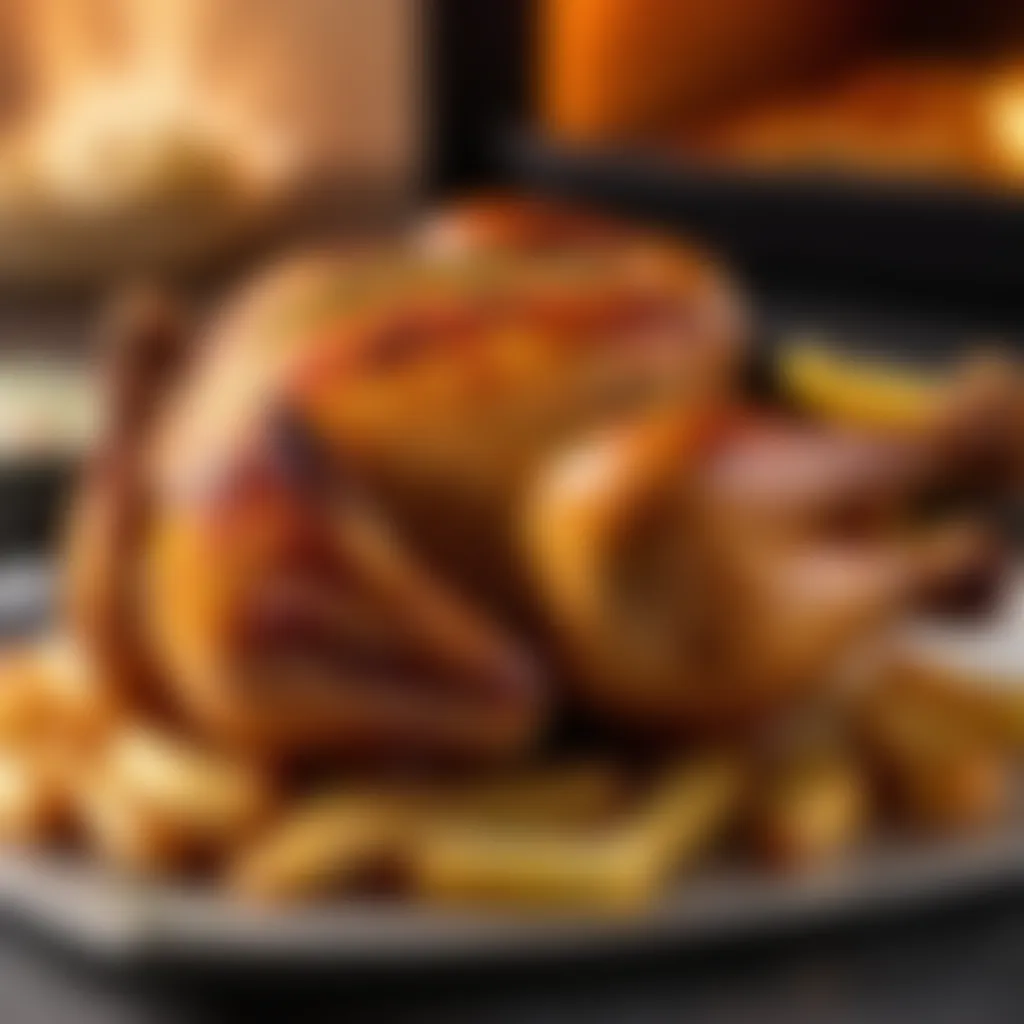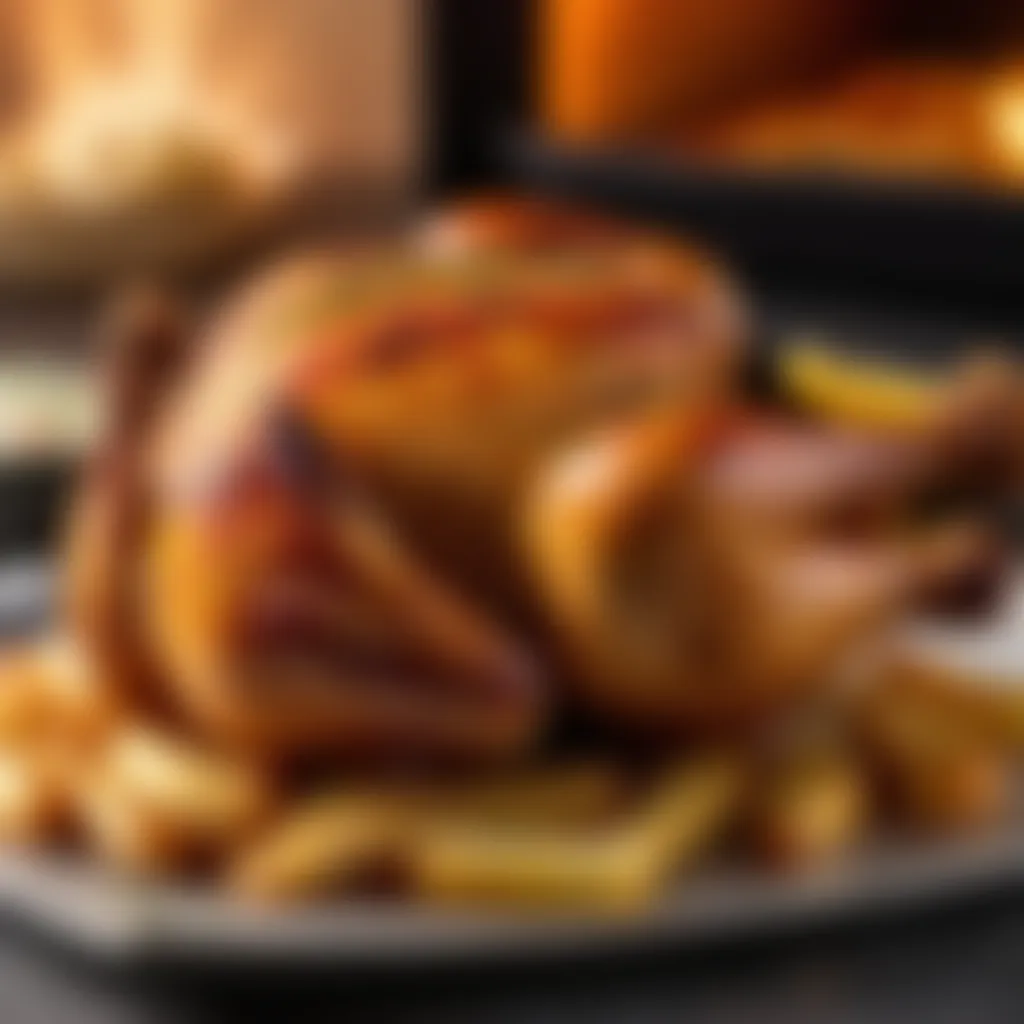Mastering the Art of Air Frying: A Complete Guide


Intro
Cooking can sometimes be overwhelming, even for the most seasoned chefs. The numerous gadgets and appliances available can complicate what should be a straightforward process. Thankfully, the air fryer emerges as a game-changer in the kitchen, blending the best aspects of frying, grilling, and baking all in one neat package. Whether you're a novice trying to navigate your new air fryer or someone experienced looking for fresh ideas, you’ll find valuable insights that will make cooking with this appliance a delight.
In this guide, we'll not only examine how to get started with an air fryer but also cover various techniques, traditional and innovative recipes, and tips that can elevate your cooking experience. Understanding how this appliance operates and the advantages it offers will begin your culinary journey, where health consciousness can meet deliciousness.
Prelims to Air Frying
Air frying has become a household term in recent years, as more and more people lean towards healthier cooking methods without sacrificing taste. This section will lay the groundwork for understanding the significance of air fryers in contemporary kitchens, emphasizing their key features, health benefits, and ease of use. By the time we dive into the details, you'll see why air frying deserves a spot in your culinary toolkit.
Understanding the Air Fryer Technology
At its core, an air fryer is a kitchen appliance that circulates hot air around food to create that coveted crispy texture similar to deep frying, but using minimal oil. The technology behind this gadget leans heavily on convection cooking. The heated air rapidly moves throughout the cooking chamber, cooking the exterior of the food while maintaining moisture inside.
To illustrate, consider the preparation of chicken wings. When tossed into the air fryer, they come out golden brown and crispy after only a fraction of the time spent in traditional frying methods. Using just a tablespoon or two of oil, you can enjoy wings that are significantly lower in fat, yet everyone still loves munching on them for game day! It’s a win-win in every sense.
History and Evolution of Air Fryers
The journey of air fryers began in the early 2000s, with the technology slowly evolving from rudimentary designs to the sophisticated versions we see today. The introduction of the first home air fryer in 2010 marked a turning point in cooking dynamics. Initially, models like the Philips Airfryer turned heads with their ability to cook food with very little oil.
Since then, air fryer designs have multiplied, bringing various features such as digital controls, pre-set cooking functions, and even rotisserie options that open a new world of culinary possibilities.
With each passing year, advancements in air frying technology continue to attract a wider audience eager to explore healthier yet delicious cooking options. As the trend grows, so does the range of foods and dishes adaptable to air frying, from crispy falafel to perfectly roasted vegetables. The evolution means it's becoming increasingly easier for anyone to dabble in air frying, turning anyone into a culinary enthusiast.
"Embrace air frying; it’s not just about healthier eating. It's about rediscovering the joy in cooking without excessive oil while still satisfying cravings for crispy textures."
Understanding both the technology and the historical context enhances your appreciation for air frying as more than just a kitchen gadget. It's a movement toward healthier eating habits, making it invaluable not just for seasoned chefs, but also for those at home wanting to whip up quick, healthy meals for their families.
Benefits of Using an Air Fryer
When it comes to modern cooking appliances, the air fryer stands out as a game changer in the kitchen. The benefits of using an air fryer not only transform how we approach cooking but also offer a plethora of advantages that cater to a wide array of cooking needs. In fact, understanding these benefits could very well make you consider adding one to your culinary arsenal if you haven’t already.
Healthier Cooking Options
One of the standout features of the air fryer is its ability to mimic the crispiness of fried foods without the excess oil. This particular aspect makes it an ideal gadget for health-conscious cooks. Using hot air circulation rather than traditional frying methods, air fryers require considerably less oil—often just a spritz or a tablespoon at most. For instance, you could take a standard recipe for chicken wings that calls for deep-frying in a cup of oil. By switching to an air fryer, you can achieve the same delightful crunch with just a fraction of the fat. Not only does this reduce calorie intake, but it also cuts down on saturated fats, which is a plus for heart health.
"Cooking with less oil doesn't mean compromising taste; it’s a win-win for your health and your taste buds!"
Time Efficiency in Meal Preparation
Time is often of the essence in bustling homes, especially for housewives managing multiple tasks. Air fryers are designed to cook food faster than conventional ovens. Because they circulate hot air, they can reduce cooking times by up to 20-30%. For instance, a traditional roasted potato might take nearly an hour in the oven, while in an air fryer, it’s ready in about 25 minutes. With preheating times negligible or non-existent, you can whip up a meal for your family in half the time. Imagine prepping dinner while allowing your kids to do homework, then presenting a piping hot meal in record time.
Versatility Beyond Frying
Another compelling benefit is the versatility that air fryers bring to the table. While they are often associated with frying, they can be used for a variety of cooking methods. This appliance can roast, bake, grill, and even reheat leftovers effectively. You may find yourself making everything from crispy French fries to roasted vegetables or even baking a small cake. Plus, air frying can enhance flavors that other methods might not reach—like perfectly caramelized Brussels sprouts or succulent yet crispy fried fish. This kind of adaptability is crucial for anyone looking to fine-tune their cooking skills or simply whip up a quick meal.
In summation, the decision to incorporate an air fryer into your kitchen routine boils down to its numerous benefits. It’s not just about healthier eating; it’s also about saving time and expanding the repertoire of dishes you can produce. If that’s not a winning combination, then what is?
Choosing the Right Air Fryer
When it comes to cooking with an air fryer, the first step is choosing the right one. The right air fryer can drastically change your cooking experience. You want something that fits well with your lifestyle, meets your needs, and helps you whip up delicious meals without hassle. Think of it like selecting the right tool for a job; having the right tool can make all the difference between a smooth operation and a frustrating experience.
Key Features to Consider


When you’re sifting through the myriad options available, several key features should guide your decision. They can significantly enhance how well an air fryer works in your kitchen. Let’s break down the critical elements:
Capacity and Size
Capacity and size play a crucial role in the selection process. If you're feeding a large family, a smaller model might just leave you frustrated, cooking in batches. On the flip side, a larger model may take up too much precious counter space in a compact kitchen. A typical family-size air fryer generally has a basket capacity of around 5 to 6 quarts, which tends to be sufficient for a dinner for four.
A key characteristic of capacity is how it affects meal preparation. With a larger basket, you can brown and crisp multiple chicken thighs at once, rather than doing several rounds. It’s a beneficial choice for families who appreciate efficiency. The unique feature of size is that many air fryers are designed to fit snugly on countertops, especially those with a profile that isn’t overly tall. On the downside, larger models can be cumbersome and difficult to store when not in use.
Temperature Range
Next up, we have temperature range. It’s ideal for air fryers to have a range between 180°F to 400°F. This gives you the flexibility to cook a variety of foods perfectly— from crispy fries to baked desserts. The key characteristic here is versatility; a wider temperature range allows you to tackle a greater number of recipes.
For instance, some air fryers even have specialized settings for things like roasting or baking, enhancing their functionality even more. The downside? Some of the higher-end air fryers can feel a bit daunting with their multitude of settings, which might be overwhelming for those just starting out in their air frying journey.
Control Options
Control options are paramount when it comes to usability. You’ll want an air fryer that offers intuitive controls—think dials, buttons, or even a digital display. This aspect contributes to how user-friendly the air fryer is, making it simpler for you to set time and temperature.
A beneficial choice here is a model that allows for programmable settings. This means you could toss in a batch of veggies, set the timer, and walk away. Unique features like preset cooking programs can help less experienced cooks feel more confident in experimenting with different dishes. But take note: if an appliance has too many options, it can lead to a confusing interface, which may discourage you from trying new recipes.
Comparing Popular Brands
Once you’ve got an idea of the features you want, it’s time to eye the specific brands that stand out in the marketplace. While some brands might shy away from robust functionality, others focus on user experience and versatility.
From heavyweights like Ninja to the sleek designs of Cosori and the tried-and-true reliability of Philips, each brand has its unique strengths. Brands like Instant Pot even combine air frying with multiple cooking functions, creating a more comprehensive kitchen gadget. Researching customer reviews online, particularly on platforms like reddit.com or facebook.com, can give a clearer picture of user satisfaction and common issues.
To wrap it up, the task of choosing the right air fryer isn't a walk in the park, but being well-informed can help navigate this crowded market. Focusing on capacity, temperature range, and control options can make your air frying journey all the more enjoyable.
Mastering Air Frying Techniques
Mastering the art of air frying is pivotal for anyone looking to elevate their culinary skills, especially within the unique landscape of cooking. The use of an air fryer isn't just about frying food; it's a gateway to healthier cooking and creative meal prep. Understanding techniques will directly influence the taste and texture of your dishes.
With a little know-how, you can make your air fryer a versatile tool that enhances your everyday cooking experience.
Preheating and Oil Usage
Preheating your air fryer is like getting a pot of water boiling before adding pasta. It sets the stage for even cooking and can significantly reduce the overall cooking time. Proper preheating leads to evenly cooked food with crispy textures, so it's worth taking the time to do it right.
When it comes to oil, it's a common misconception that air frying means no oil at all. While it does use significantly less than deep frying, a touch of oil can do wonders. A light misting, or tossing your ingredients with a small amount, encourages browning and crisping, enhancing flavor. Too much oil, however, can counteract the health benefits that air frying offers.
Adjusting Recipes for Air Frying
Adapting traditional recipes for air frying is also key to mastering this technique. Many classic dishes can be modified for the air fryer, making them healthier and faster. Below are a pair of significant adjustments to think about.
Temperature Modifications
Adjusting the temperature for air frying is essential. Most recipes designed for conventional ovens can be tweaked by reducing the temperature by about 25°F (approximately 14°C). This adjustment ensures cooking happens at a rate that the air fryer can manage without overcooking the exterior before the interior is done.
This practice becomes a beneficial choice because it aligns with the efficiency of the air fryer. By using a slightly lower temperature, you permit the hot air to circulate around the food, ensuring a cooked interior while still achieving that desirable golden finish on the outside.
The unique feature of this technique is its adaptability. If a dish typically suggests 400°F, try 375°F instead. This creates the potential for perfectly cooked meals that can impress even the pickiest eaters.
Timing Adjustments
Timing is another critical factor when you transition to air frying. Most recipes recommend cooking slightly less time in an air fryer compared to conventional methods. Generally, you might consider decreasing cooking time by about 20%. This reduction often prevents food from drying out and allows for a better texture.


The key characteristic here is precision. Air fryers cook food faster due to rapid air circulation, thus making it very important to monitor your meal as it cooks. The uniqueness of timing adjustments is that it opens up a whole new realm of experimentation.
The positives can outweigh the negatives, especially if you make an effort to check the food periodically. It guarantees that you won’t overcook or burn your culinary masterpiece, leading to healthier and more enjoyable meals.
Creative Air Fryer Recipes
Exploring the realm of air frying opens up an exciting world of culinary creativity. Creative Air Fryer Recipes enable cooks to push the boundaries of traditional cooking methods, allowing for delightful discoveries. The significance of this section lies in its potential to transform how meals are prepared at home. With air fryers offering faster cooking times and healthier outcomes, ingenious recipes cater to various tastes and dietary needs. Not only can you whip up appetizers for gatherings, but you can also craft main dishes and sweet delights that dazzle at the dinner table.
Highlights of Creative Air Fryer Recipes:
- Healthier Alternatives: By utilizing the air fryer's ability to cook with less oil, recipes can keep those unwanted calories at bay without sacrificing flavor.
- Time-saving: Many creative recipes come together swiftly, making them perfect for busy households where time is of the essence.
- Diverse Options: Whether you're looking for vegan, gluten-free, or hearty comfort foods, there's something for everyone.
"Cooking is like love; it should be entered into with abandon or not at all."
— Harriet Van Horne
Appetizers and Snacks
When it comes to appetizers and snacks, the air fryer shines brightly. Imagine crispy onion rings, buffalo cauliflower bites, or even air-fried calamari that rival restaurant-quality. The beauty of preparing these bites lies in the flavor preservation while minimizing oil usage. For example, air frying enchilada rolls or cheese-stuffed jalapeños transforms ordinary snacks into extraordinary culinary delights.
Simple Ideas for Snacks:
- Air Fryer Veggie Chips: Thinly slice your favorite vegetables, season them, and crisp them up in the air fryer.
- Stuffed Mushrooms: Incorporate a savory filling into mushrooms before air frying them to tantalizing perfection.
- Mini Quiches: Whisk together eggs, veggies, and cheese, place in muffin tins, and air fry for a quick twist on a classic.
Main Dishes
Main dishes cooked in an air fryer can truly be a game changer; it’s all about thinking beyond fried chicken. Picture succulent roasted chicken, perfectly seared fish, or a vegetable medley that keeps its vibrant flavors intact. Recipes for air-fried stuffed bell peppers or quinoa bowls can cater to various diets, from a humble weeknight meal to a special celebration.
Suggestions for Outstanding Main Courses:
- Crispy Air-Fried Chicken Thighs: Marinate chicken thighs and let the air fryer bring them to crispy goodness.
- Stuffed Zucchini Boats: Fill zucchini halves with a mix of protein, grains, and spices before air frying them to plush perfection.
- Teriyaki Salmon: This dish blends Asian flavors beautifully, quick to prepare and bursting with zest.
Desserts and Treats
Desserts deserve a special spotlight when showcasing the air fryer’s versatility. You might be surprised how easily you can whip up a batch of chocolate lava cakes or air-fried apple fritters. Baking in an air fryer can yield moist, flavorful results with reduced cook times, making the previously daunting task of baking feel much more approachable.
Delicious Air Fryer Dessert Ideas:
- Mini Cheesecakes: These bite-sized treats can be made in cupcake liners for portion control.
- Banana Bread: Slice bananas and air fry to create a quick and satisfying treat with a crispy edge and soft interior.
- Nutty Brownie Bites: The air fryer can make brownies that are delightfully gooey on the inside while achieving that beloved crust on top.
Common Air Fryer Myths and Facts
Many household kitchens now boast an air fryer, a device that promises quick, crispy meals without the heaviness of traditional frying. However, despite its rise in popularity, air fryers are often surrounded by a fog of misconceptions that can muddle understanding. Dissecting these myths is vital, not just for those considering adding one to their kitchen arsenal, but also for seasoned users wanting to maximize their cooking potential.
Developing a strong grasp of what’s true and what’s not about air fryers can help you take full advantage of their unique cooking methods. Not to mention, it can save you time, effort, and the occasional disappointment in the kitchen.
"Understanding air frying myths can enhance your cooking journey, making each meal a source of joy rather than frustration."
Debunking Misconceptions
Misconceptions about air fryers are as common as dirt on a kitchen floor. Let's clear up a few.
Myth 1: Air fryers are just mini ovens.
While it’s true that both appliances cook food, air fryers use a different mechanism. They circulate hot air at high speed, giving that crispy texture similar to deep frying. A traditional oven may cook food, but it doesn’t do it with the same efficiency.
Myth 2: You don’t need any oil at all.
There’s a belief you can cook entirely without oil in an air fryer. While you certainly can use very little oil, completely skipping it can lead to dry results. A light spritz or brush can go a long way in achieving flavor and crispiness.
Myth 3: Everything cooks faster in an air fryer.
This one varies. Some foods do indeed cook more quickly, but others may require some adjustment in timings. The compact cooking space can sometimes lead to uneven heating, making it essential to keep an eye on your dish.


Myth 4: Air fryers only fry food.
In reality, air fryers can handle various cooking methods — baking, roasting, grilling — allowing you to whip up much more than French fries. You might be surprised by what delicious treats an air fryer can offer.
The Science Behind Air Frying
Understanding the science behind air frying adds another layer to its appeal. An air fryer employs a powerful fan that rapidly circulates air — a clever little mechanism often referred to as "rapid air technology." This movement mimics the frying process by sending hot air across food, crisping it while keeping the inside moist.
One might think of this as a culinary dance: hot air rises while cooler air moves in, creating a convection current. This current is what allows the food to cook evenly, effectively reducing cooking times compared to conventional methods.
Several factors contribute to the effectiveness of air frying.
- Temperature Control: Air fryers can reach high temperatures quickly, giving the food that desirable crispy layer on the outside while maintaining tenderness inside.
- Moisture Retention: By cooking quickly, air fryers trap moisture within the food, preventing it from drying out, which is crucial, especially for meat.
- Crispy Finish: The powerful fan ensures that each piece of food gets equal exposure to heat. This makes for an even browning that is tough to achieve with other methods.
In summary, knowing the science gives confidence in air fryer use. So, the next time someone mentions air frying, you can not only quash those myths but also shed light on how it actually works.
Maintenance and Safety Tips
Taking care of your air fryer is just as critical as learning how to use it. Proper maintenance ensures longevity while also guaranteeing that your meals are prepared safely and effectively. Without the right care, your trusty kitchen companion might become a source of frustration instead of joy. Investing time in maintaining the appliance can prevent common issues and extend its lifespan, as well as ensure the food you cook is healthy and delicious.
Cleaning Your Air Fryer
Cleaning might not be the most thrilling task, but doing it right after you finish cooking can save you a ton of headaches later. Regular cleaning of your air fryer prevents grease build-up and odor retention, both of which could ruin the flavor of your carefully crafted meals. Here’s how to do it effectively:
- Unplug and Cool Down: Always unplug your air fryer and give it some time to cool down to avoid burns.
- Disassemble: Remove the basket and any detachable parts. Most of them are dishwasher safe; however, double-check the manufacturer's instructions first.
- Soak and Scrub: Soak these parts in warm soapy water for a few minutes, then use a soft sponge to scrub off any food residues. Avoid using abrasive tools to prevent scratches.
- Wipe the Main Unit: For the main unit, gently wipe it with a damp cloth. Be cautious not to let any moisture seep into the electrical components.
"Taking a few minutes to clean your air fryer after each use goes a long way in maintaining its performance."
- Dry Thoroughly: Ensure all components are completely dry before reassembling. This helps avoid rust or mold buildup.
- Inspect Periodically: Every once in a while, keep an eye on the heating element. If you notice any debris, simply wipe it down gently.
Regular cleaning not only maintains performance but also ensures food safety, making this step non-negotiable in effective air frying.
Safety Precautions During Cooking
Cooking with an air fryer is generally safe, but it's not devoid of risks. Being cautious can help you create a worry-free environment in your kitchen. Here are some safety tips to keep in mind:
- Positioning: Place your air fryer on a stable, heat-resistant surface. Keep it at least a few inches away from walls or other cookware to ensure proper airflow and avoid overheating.
- Monitoring Food: It's easy to forget your air fryer is on, especially if you're multitasking. Keep an eye on the cooking process to prevent any potential hazards.
- Avoid Overfilling: An overflowing basket can lead to uneven cooking and possible spills. Stick to recommended capacities to maintain efficiency and safety.
- Use Utensils Wisely: Stick to silicone or wooden utensils when handling your food inside the air fryer. Metal tools can scratch the non-stick surface and potentially damage the appliance.
- Be Wary of Steam: When you open the fryer, be cautious of the steam that escapes. It can burn your skin if you're not careful. Open the lid slowly to let the steam vent out.
Incorporating these maintenance and safety practices into your air frying routine will not only enhance your cooking experience but also keep you and your loved ones safe while enjoying the tasty meals prepared in your appliance.
The Future of Air Frying
As we look ahead, it is clear that air frying is more than just a fleeting trend; it represents a shift in the way we approach healthy cooking. The importance of this topic in our discussion is paramount, as it encompasses not only technological advancements but also evolving culinary practices that can benefit both health-conscious individuals and busy households. Understanding the future of air frying helps us remain aware of the innovations on the horizon, while also embracing the changing landscape of nutritional eating.
Innovations in Air Fryer Technology
The heart of the future lies in innovations in air fryer design and capabilities. Manufacturers are continuously seeking to integrate cutting-edge technology into their products, enhancing the user experience and cooking efficiency. Here are some noteworthy advancements:
- Smart Features: Many new air fryers are equipped with Wi-Fi connectivity, allowing users to control settings through their smartphones. This means you can preheat your device or start cooking while you attend to other chores, thus bringing convenience to your busy lifestyle.
- Multi-Functionality: Modern air fryers are evolving into multi-cookers that not only fry but also bake, grill, and dehydrate food. This versatility is a significant leap, catering to diverse culinary needs and helping to save space in the kitchen.
- Energy Efficiency: Manufacturers are focusing on energy consumption, striving to design appliances that cook more efficiently without compromising on performance. This cuts down utility costs while promoting more sustainable practices in the kitchen.
- Improved Heat Distribution: Newer models are coming with enhanced air circulation systems that provide more even cooking. This technology helps in achieving beautifully crispy textures and perfectly cooked meals without requiring excessive oil.
"The continual advancement in air fryer technology is making healthy cooking accessible and efficient for everyone."
Such developments reassure cooks that the air fryer is here to stay, solidifying its place as an indispensable kitchen appliance.
Emerging Trends in Healthy Cooking
As the world becomes increasingly health-conscious, several trends are emerging in the realm of healthy cooking that directly relate to the future of air frying. These trends not only shape consumer choices but also influence how air fryers are adapted to meet those demands:
- Plant-Based and Clean Eating: With more people adopting plant-based diets, recipes tailored for air fryers often emphasize vegetables, whole grains, and legumes. This shift encourages a creative culinary approach that takes advantage of the air fryer's ability to bring out flavors without excessive fats and preservatives.
- Global Influences: Home cooks are drawing inspiration from international cuisines, translating beloved global dishes into healthier air-fried versions. This includes air-fried samosas, falafels, or even plantain chips, making diverse cuisine more accessible and healthier.
- Meal Prepping and Batch Cooking: Air frying is also becoming increasingly popular in meal prep practices, where busy households look for ways to cook large quantities of food quickly. The air fryer’s efficiency allows for meal preparation to be streamlined, appealing to an audience that seeks to save time while providing nutritious meals for their families.
- Focus on Whole Foods: There is a growing emphasis on using whole food ingredients. The air fryer complements this trend perfectly since it encourages cooking with less oil and more natural flavors, maintaining the nutritional integrity of foods.
Incorporating these trends can undoubtedly enhance the cooking experience with an air fryer, making it an essential tool for those who are health-focused yet desire convenience in their kitchen.
As we progress into a future filled with culinary innovation, the air fryer is poised to evolve alongside our changing palates and dietary needs. It stands as a beacon for healthier cooking options, enabling individuals to whip up delightful meals without compromising on health.







